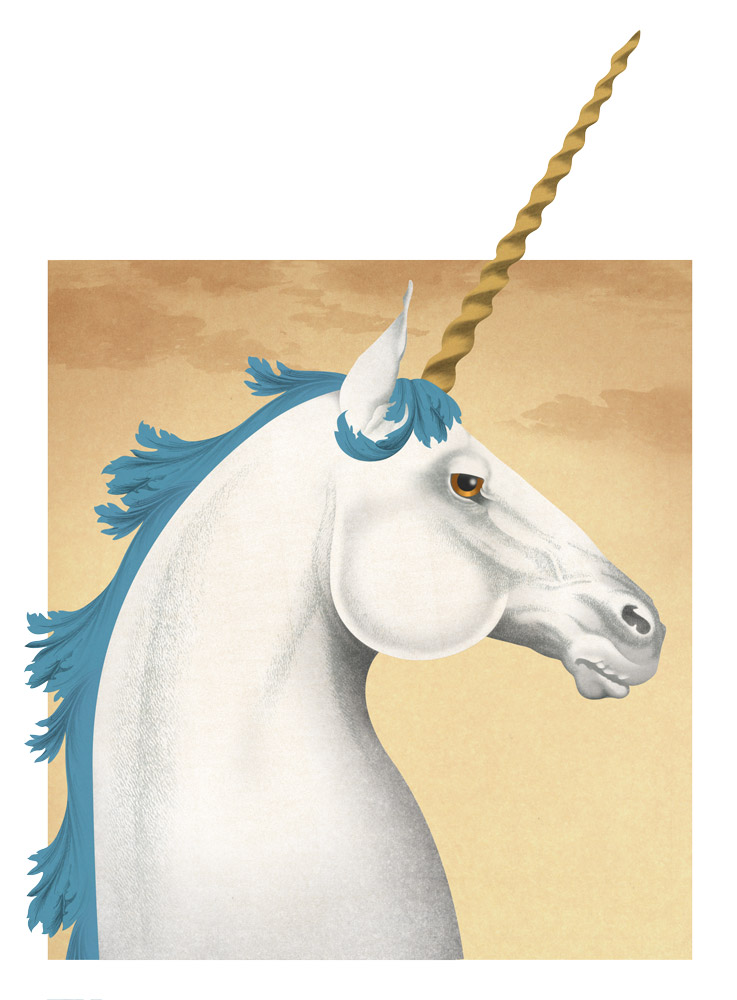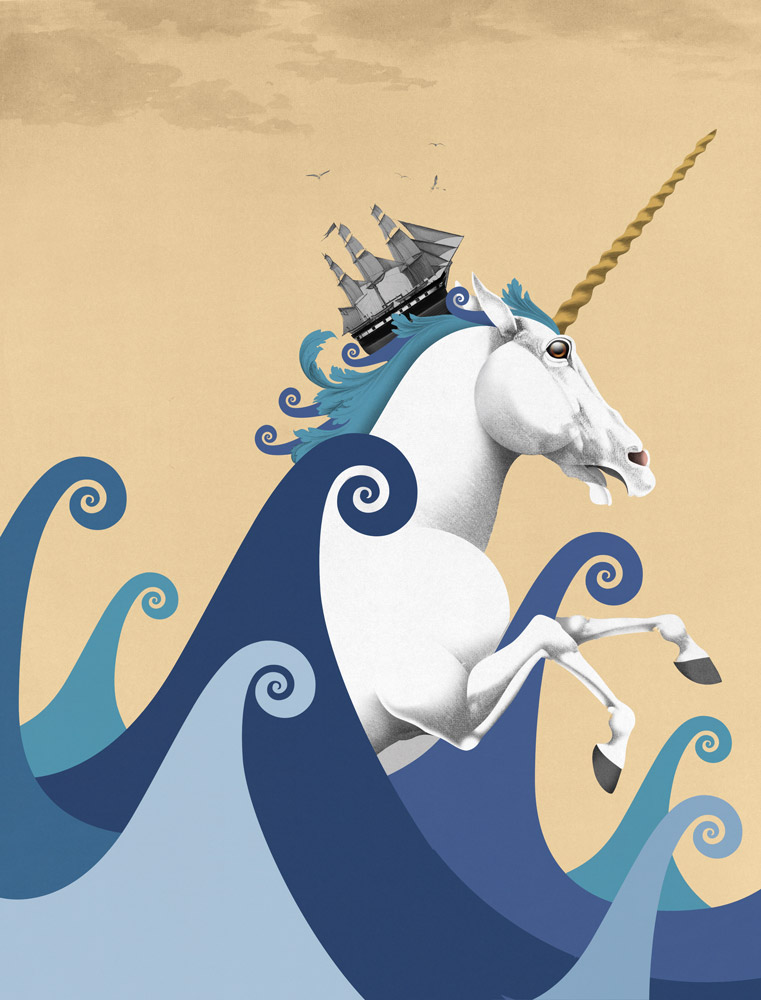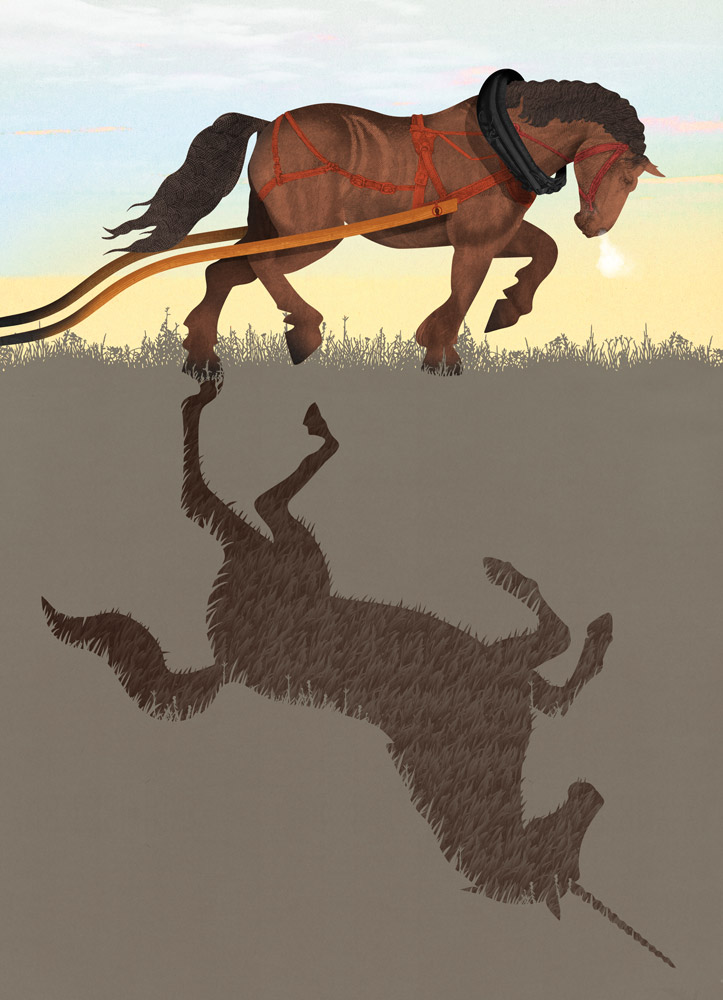CHASING UNICORNS
By | Spring 2020
HYPERGROWTH IS THE ULTIMATE TEST OF A LEADER'S METTLE. WHAT SEPARATES THOSE LEADERS WHO FLOURISH FROM THOSE WHO FAIL — OR TURN OUT TO BE FRAUDS?

Two centuries ago, the first venture capitalists chased whales. Or, more precisely, they invested in the voyages of sea captains who did. That is the view of venture capital that Tom Nicholas presents in “VC: An American History.” Nicholas describes whaling agents as the forerunners of modern venture capitalists not because their “ventures” were hazardous, with life and limb at stake, but rather because in whaling, Nicholas sees the birth of a new, uniquely American investment model — one focused on “highly lucrative, low-probability events.”
Two-thirds of whaling voyages were “broken ventures,” making no return on the agent’s investment. And sometimes, “no return” was literal: Six percent of voyages disappeared at sea, often along with captain, crew and cargo. Still, for those sea captains and agents who beat the odds, the rewards were rich. During whaling’s heyday, profits from whaling ventures made the seaport town of New Bedford, Massachusetts, the richest place per capita in all of North America.
Today’s venture capitalists pursue a very similar high-risk, high-potential investment model. But they have long since traded the gritty sea captains and New England seaports for savvy tech entrepreneurs and Silicon Valley. No longer do VCs dream of whale hunts. Instead, they are chasing unicorns.
A “unicorn” is a private startup company valued at over $1 billion. And over the past decade, $763 billion in new investments have led to the rapid creation of unicorn companies. When venture capitalist Aileen Lee coined the term “unicorn” in 2013, there were only 43. Today, there are more than 400. Some, like Uber and Airbnb, have created entirely new categories of business.
But just like the great whaling ventures of the 19th century, there have been a number of cataclysmic failures. Following the Silicon Valley mantra “move fast and break things,” some founders, including Uber’s Travis Kalanick and WeWork’s Adam Neumann, nearly ran their ships aground and were subsequently ousted from their leadership positions. And some latter-day Captain Ahabs, like Elizabeth Holmes at Theranos, have plunged theirs into sheer oblivion.
What can we learn from these booms and busts? Some researchers and entrepreneurs say we should begin to question common Silicon Valley assumptions about the type of leadership required to build a hypergrowth company, or “raise a unicorn,” so to speak. In the light of a little data and math, many say, the myths have begun to unravel.
THE GENIUS HYPOTHESIS
One common assumption, shared by the public and investors alike, is that the driving force behind every unicorn is genius — usually in the form of a brilliant founder and/or CEO. Let’s call it the “Genius Hypothesis.”
Disgraced Theranos founder Elizabeth Holmes was well aware of this assumption and used it to her advantage. She literally dressed the part, donning a Steve Jobs-inspired black turtleneck as her unofficial uniform. She exploited her status as a Stanford dropout with a history of entrepreneurship in her family.
Holmes used the image of herself as a genius to woo an impressive board of directors for her company that included such luminaries as former secretaries of state Henry Kissinger and George Schultz. And she used it to secure major investments from the family of Secretary of Education Betsy Devos and media mogul Rupert Murdoch, each of whom saw $100 million or more of investment money go down with the ship when Theranos was dissolved in 2016.
To say that the Genius Hypothesis is a myth is not to say that talent doesn’t matter. Intelligence, courage and maybe even a little hubris can help an entrepreneur. As Google futurist Ray Kurzweil puts it, as an entrepreneur, you need “to follow your own thought experiments and not fall off the horse because the conclusions are so different from your previous assumptions or the common belief of society.” Jeff Bezos put it even more simply: “If you’re going to do anything new or innovative, you have to be willing to be misunderstood.”
The point is that, by itself, talent is limited. While courage and vision might be indispensable for entrepreneurial success, they are also insufficient, argues Nicholas Berente, the Viola D. Hank Associate Professor of IT, Analytics, and Operations at Mendoza College of Business.
Before his academic career, Berente founded two technology companies, and he says both his experience and the data reveal that great entrepreneurs are not lone geniuses. Often successful founders work with trusted partners. And neither are they inexperienced wunderkinds. The average age of a successful startup founder, he points out, is 45. Successful entrepreneurs have put in their time, in other words, and have experienced failures — sometimes serious ones — along the way.
Dean Shepherd, the Ray and Milann Siegfried Professor of Entrepreneurship at Mendoza, agrees with Berente. While he admits “there may be some personality characteristics that are associated with entrepreneurship,” he maintains that the effect of innate traits and natural abilities is “small enough that we can work with them or overcome them to achieve entrepreneurial success.”
The key, in other words, is to recognize that great entrepreneurs aren’t born, they’re made. Instead of attempting to locate the entrepreneurial needle in the haystack, Shepherd says we should focus on the “the attitudes, decisions and actions that people take that impact their future.”
But what might those attitudes, decisions and actions be?
LOOK TO GROWTH, NOT TO GENIUS
If it’s wrongheaded and sometimes disastrous for investors to rely on the Genius Hypothesis of entrepreneurial success, it might be just as damaging for the entrepreneurs themselves.

Jay Newman (BBA ’02), director of strategy at Jump Associates, sees proof of this fact in psychologist Carol Dweck’s research on “mindset.” For Dweck, those with a “fixed mindset” see success as driven largely by innate ability. Dweck points out that those with a fixed mindset often undermine themselves through a fear of personal growth, change and failure. Instead, Dweck argues, we need to embrace a “growth mindset,” driven by the conviction that success is the result of learning and growth, often as the product of failure.
Newman uses Dweck’s insights in his work at the San Francisco Bay Area growth strategy firm. He says he finds that personal growth and business growth interrelate. “A company growing a service to an increasingly large set of customers or affecting an increasingly large set of stakeholders is going to deal with more complexity and more conflict. If you lead an organization that goes from five employees to a thousand employees,” he explains, “everything will have changed between, and so you need to change, too.”
He also finds that sometimes leaders’ genius can lead to success, but it cannot keep them there. “Success is increasingly short-lived for all sorts of different reasons in our very, very fast world,” he says. “The leader of a hypergrowth unicorn needs to be someone who believes that the people around him or her can change if they work at it, that they themselves as a leader can change and that’s going to be a good thing.”
Research by Michael Mannor, the John F. O’Shaughnessy Associate Professor of Family Enterprise at Mendoza College of Business, suggests that a major part of handling hypergrowth is warding off extreme anxiety and its negative effects. Along with colleagues Adam Wowak, Viva Bartkus and Luis Gomez-Mejia, Mannor recently surveyed 84 top executives of large organizations, their decision making teams, their friends and families. His team was able to develop a clearer picture than ever of how anxiety shapes leaders’ decisions.
Their findings suggest, Mannor says, that, “When you have more job anxiety, you tend to surround yourself with loyalists and that can create an information buffer around you so that you don’t see the world as it really is. You might believe that you do, but you don’t because these people tell you what you want to hear.”
Mannor suggests that this echo chamber effect is likely to be especially strong in hypergrowth companies. “If you’re going to raise a unicorn,” Mannor says, “that brings a boatload of anxiety potential: You feel the pressure to produce returns for the venture capitalists; you feel pressure from your family; you feel pressure because there’s such a brief window for you to achieve exponential growth.”
Another less obvious source of anxiety comes from what Mannor and his colleagues call a “loss frame.” For those of us looking at a unicorn from outside in, it may appear to be a sure ticket to comfort and wealth.
But the founder may experience it differently. “Most of us look at a founder from the outside and say, “You can make $150 million — cash out!” Mannor explains, “but for the founder, there’s a $5 billion valuation coming in a few years. They are incredibly focused on not messing it up.” For those leaders who can’t step back, gain perspective and reduce the anxiety, an even more skewed view of reality and even poorer decisions are likely to result.
BUILD A CULTURE, NOT A CULT OF PERSONALITY
One person who can speak about what hypergrowth looks like from the inside is Tom Mendoza (ND ’73).
After joining the team at tech startup NetApp in its early stages, he oversaw the company’s growth including when it rose from $250 million to $1 billion in revenue in just two years and joined the Fortune 500. “That was classic hypergrowth in the days of the dot-com boom,” Mendoza says. Today, Mendoza serves on the board of a unicorn company called UiPath, which reached a $7 billion valuation last year.
The first thing Mendoza says about hypergrowth is that it is good. He calls it a “high-class challenge.”
He explains, “In business, you’re always going to have a challenge. The question is, are they high-class challenges or low-class challenges? A low-class challenge is when nobody wants your product; you’re not making anything anybody wants to buy. Or when you’re asking, ‘How many people can we cut so that our earnings are good enough that the stock can do OK?’ That’s a low-class challenge.
“But when you’re saying, ‘People really want what we have, we’re growing at a rate no one foresaw, and now we have to figure out on the fly how we’re going to manage this unique business and grow it’ — that’s a high-class challenge,” he adds.
Mendoza doesn’t downplay the difficulty involved in hypergrowth from a leader’s perspective. He says he has tremendous respect for the entrepreneurs who are raising unicorns. “Having been involved with some very high growth companies,” he says, “it’s not like there’s not really good leaders doing it; it’s just a hard challenge.”
Mendoza says hypergrowth leaders all make mistakes, but what separates the great leaders from the not-so-great ones is how they respond. The question is, “Do you acknowledge your mistakes? Do you learn from them?” he says, “That’s how great companies are built.”
For him, the key is to move a hypergrowth company away from a cult of personality or brilliance and to focus instead on building the company’s culture. One reason has to do with innovation itself. Mendoza sees innovation as too important and vital to the business’ success to be left in the hands of one lone individual, genius or not.
“The tech world is the world of shooting stars,” he says. “Someone had one good idea. They ran hard with it. But when a competitor comes along or the world changes or they have to come up with a second idea, they need a culture. You need people to be candid, and you have to be humble enough to understand that you need other people’s opinions.”
A lack of focus on culture is the number one reason companies fail, according to Mendoza.
In the case of NetApp, Mendoza says the culture of the company was set early on at the company’s first offsite meeting. “The CEO asked, ‘What is our mission? What is our why? Why are we doing it?’” says Mendoza. “The answer the leadership team came up with was, ‘We want to build a company that we can be proud of for the rest of our lives.’”
For NetApp, this answer was like a GPS. It informed every decision, especially the way the team hired, evaluated employees and promoted them. This mission also transferred on to employees, who, according to Mendoza, collectively answered, “This is exactly what I’ve been looking for. I want to be part of something I can be proud of.”
Culture also matters because eventually every company will encounter tough times — whether it’s the leader’s fault or not. “You’ve got to understand that a situation that seemed positive could change in a heartbeat, especially in tech,” he says. During downturns, the company’s culture will reveal itself and quite likely, it will determine whether the company survives.
During the dot-com bust, Mendoza says, “If you had a bad culture or had implemented bad business practices because of the hypergrowth, everything happened fast — including hitting the wall.”
The same, he says, is true today: “In many of these hypergrowth companies with one person at the top who’s just focused on themselves, people will probably stay with the leader as long as it looks like everybody’s going to make a lot of money. But as soon as there’s a doubt or it starts to go sideways, you see everybody running. That’s because they don’t have a culture. There’s no culture that people are there for.”
As the saying goes, “When the tide goes out, you see who’s swimming naked.” And the tide, of course, always goes out.
BEYOND THE UNICORN ERA
Silicon Valley saw 2020 usher in a wave of layoffs, and many investors were becoming concerned that the startup bubble was beginning to deflate. Tom Mendoza’s words sounded wise. By the end of the first quarter of the year, they sounded downright prophetic. Hard times had set in almost out of nowhere as the coronavirus pandemic swept the globe.
 Some unicorns were hit especially hard. As travel bans and social distancing practices went into effect, Airbnb, one of the largest unicorns, quickly racked up hundreds of millions of dollars in losses. Added on top of the already gathering skepticism, was this a tipping point? Was it the beginning of the end of the unicorn boom?
Some unicorns were hit especially hard. As travel bans and social distancing practices went into effect, Airbnb, one of the largest unicorns, quickly racked up hundreds of millions of dollars in losses. Added on top of the already gathering skepticism, was this a tipping point? Was it the beginning of the end of the unicorn boom?
History suggests that great disasters can sound the death knell for some high-risk ventures. It was the great whaling disaster of 1871 in which 33 whaling ships were crushed by ice off the coast of Alaska causing a loss of $1.6 million ($34.15 million in today’s dollars) that precipitated the decline of the whaling industry — even before Thomas Edison’s invention of electric lighting less than a decade later delivered the coup de grace.
And yet, there is reason to believe that whatever comes after the unicorn era will be as much evolution as revolution. Innovation — the application of creativity and insight to solve humanity’s problems — does not go out of style. And whatever the coronavirus pandemic revealed about the excesses of the startup boom, it has also brought reminders startups don’t just dream up boondoggles and doodads.
Some inventions that seemed improbable just a few years ago now bring profound benefits to our lives. Facebook and Twitter helped disseminate information about the crisis in real time. Zoom and Skype helped families and work teams stay in contact while in isolation or self-quarantine. Panopto helped teachers and professors quickly retool and take their classes online. Food deliveries from Uber Eats and Instacart allowed people to practice social distancing while supporting local eateries.
In the end, it’s hard to look at these technologies and not conclude that our lives are better for having them, the entrepreneurs who created them, and those who took the big bets to make them possible.
So hopefully, as we emerge from this crisis a little wiser, we won’t give up believing in world-changing entrepreneurial ideas. Rather, by dispelling the myths and cutting through the hype we can build the skills to couple business growth with personal growth, to build cultures and not cults, and to move fast not by breaking things but by making things that matter. Then we can grow the good in business — even if we happen to find ourselves raising a unicorn.
Illustrations by Brett Ryder

Comments